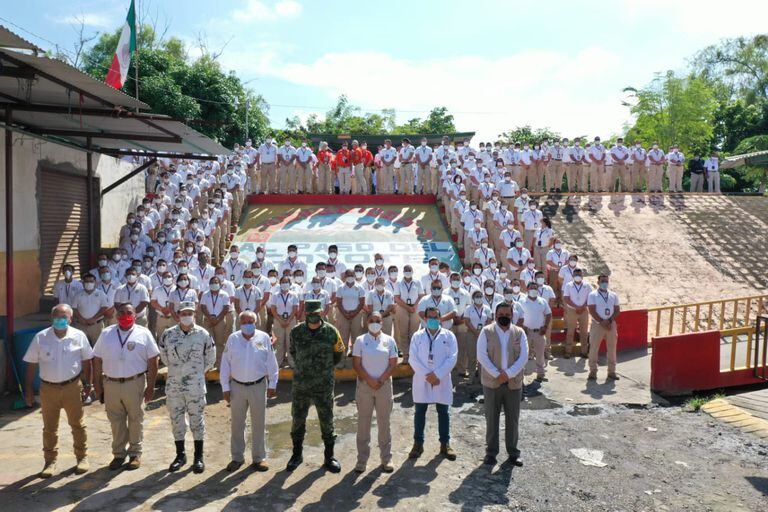Agents from the National Institute of Migration were deployed in Ciudad Hidalgo, Chiapas to prevent the entry of the migrant caravan.
A hundred migration agents have been deployed on the Mexican shore of the Suchiate River (in Chiapas), which divides Mexico with Guatemala, before the advance of the migrant caravan.
The operation coincided with an act by the head of Migration, Francisco Garduño, at this point of the border to remind that the Government will stop the advance of migrants who try to enter Mexico irregularly.
At the end of the event, the presence of the officials has diminished and Migration sources indicate to this newspaper that there is no operation underway yet.
The deployment has a significant political burden at a time when Mexico is preparing for the arrival of a new group of thousands of Central American migrants seeking to reach the United States one month before the presidential elections in that country.
President López Obrador has given clues in his morning conference this Friday about how the country will face the advance of the new caravan.
“It is a provocation, it is a matter that I believe has to do with the election in the United States.
There are indications that this was put together for that purpose.
But we are not sucking our fingers ”, declared the president.
But the migrant caravan has once again put its finger on the line of a tragedy that does not stop, independent of elections and pandemics.
The rates of violence, poverty and absence of the State in Central American countries, especially Honduras and El Salvador, where the conditions of isolation due to covid-19 have been very rigid and have exacerbated them, are now adding to a global economic crisis caused by the coronavirus.
The suffocation to which its inhabitants were subjected worsens and the safest way to escape seems to be the one they devised - with more success since 2018 - with the caravans.
On the contrary, individual or small group migration exposed them to the known migrant hell: kidnappings, rapes, executions, human trafficking, assaults at the point of a machete, cannon fodder for organized crime.
The strategy of the Mexican government since it accepted the requests of the United States to stop migration was to deploy more soldiers on the two borders.
Last year, the US president threatened Mexico with imposing tariffs on its exports if it did not take serious action on the matter.
And the Mexican president responded with 15,000 soldiers, members of the National Guard corps, on the northern border and some 6,500 on the southern border, according to Defense Secretary Luis Cresencio Sandoval.
Some agents who also had the ability to detain migrants at the border with the United States, something very unusual until now, and images such as that of a mother with her child detained by the National Guard while they crossed the Rio Grande, turned around to the world.
In addition, Mexico signed an agreement with its northern neighbor called
Remain in Mexico
(Stay in Mexico) by which in its most controversial part it promised to assume that the thousands of migrants who await their asylum procedures in the United States courts would remain in Mexico .
Even when in this country they have not started any migration process and it does not meet the conditions of the so-called safe third country, according to the human rights organizations that criticized the measure.
The last large caravan to hit the doors of southern Mexico was in January.
The migrants ran into a fence of National Guard soldiers forcibly repressing their advance.
The images of the military harshly persecuting migrants who tried to cross the Suchiate River sent a powerful message that the López Obrador government would not be lenient in its immigration policy.
And, above all, that the pressure from the United States and the outbursts of Donald Trump for the entire Mexican territory to become his great southern wall, had taken effect.
Almost eight months later, the heavy-handed policy remains the same and although the foci and resources have been used these months to alleviate the effects of the pandemic, it is expected that the authorities will stop as much as possible the entry of migrants into the country.
The first group of this caravan left San Pedro Sula (Honduras) on Wednesday night, but this Thursday and Friday 3,000 people have joined in Guatemala, as estimated by the Government of this country, which is trying to stop the route to the north, as he also promised to Donald Trump.
Some wear masks, but covid-19 seems to be the last of the concerns of those fleeing concrete death threats.
A migrant mass that reminds the world that violence and hunger continue to haunt them, with or without a pandemic.
In southern Guatemala, in Río Dulce, a group of hundreds of them have run into agents of the National Civil Police who have tried unsuccessfully to dissuade them.
The free transit agreement between the Central American countries allows them to circulate without any other documentation than that of their country of origin throughout the region.
And although the Guatemalan president, Alejandro Giammattei, ordered them to be detained in their quest to comply with what was agreed with the United States, it is not clear whether this would conflict with the provisions of the agreement.
This group is more than 1,600 kilometers from the usual point of entry into Mexico, the bridge that divides Mexico with Guatemala in Ciudad Hidalgo (Chiapas).
But many from Central America usually move by bus or hitchhiking and it takes about a little more than a day for everyone to meet in the Guatemalan border city Tecún Umán, opposite Ciudad Hidalgo.
It is here that the scale of the caravan is generally observed and the pressure towards Mexico begins.
And it is at this point where this Friday the Mexican National Institute of Migration has mobilized a hundred agents.

